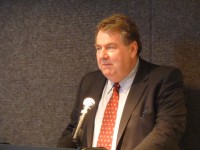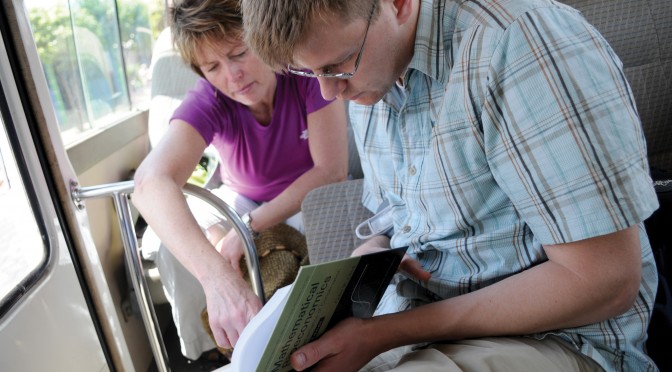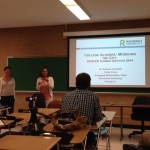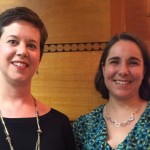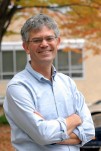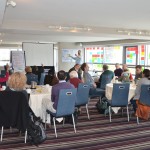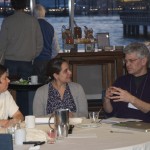David Burns
Executive Director, NCSCE
Back in February, I received an invitation from Andy Miller, a professor of mathematics at Belmont University and current past chair of the Mathematical Association of America’s (MAA’s) “SIGMAA” on Quantitative Literacy (SIGMAA QL). Andy asked me to participate in a panel to celebrate SIGMAA QL’s 10th anniversary to be held at MAA’s Summer MathFest, from Aug 6-9 in Portland, OR.
Victor Donnay of Bryn Mawr, an author of a SENCER model on differential equations and social justice and a member of our Engaging Mathematics advisory group, had recommended that Andy invite me.
Andy probably didn’t need too much persuasion from Victor to include the work of our National Center and SENCER in his panel, given that he lists one of his principal academic interests—beyond “hyperbolic dynamical systems”—as “curricular development that focuses on quantitative literacy and on issues that lie in the intersection of mathematics and social justice.”
I’ve been fascinated by something called the Mathematics Genealogy Project, so it should not have come as a surprise to me to discover that Andy’s own academic background intersects so neatly with some of the brightest stars in SENCER’s own math community: Andy’s undergraduate degree is from Wartburg, now home to Mariah and Brian Birgen, and his PhD is from Berkeley, where Dave Ferguson, a SENCER co-PI, also did his work. Indeed, when I arrived at MathFest fresh from our SENCER Summer Institute, the first person I encountered at the registration desk was Mariah, who mentioned that this was only the second SSI she had ever missed (once for a baby and this one because of a big anniversary celebration for parents on the West Coast). But I digress…
I accepted the invitation to be on the panel to spread the word about SENCER and our new Engaging Mathematics project, of course. Mostly, though, I relished the opportunity to join in the celebration of an idea: that numeracy and quantitative literacy really do matter! Indeed, along with Lynn Arthur Steen whose work on quantitative literacy and democracy has influenced my thinking and all my fellow SIGMAA QL panelists, I believe that increased capacity to engage competently in “mathematical” and “probabilistic” discourse is absolutely central to the welfare of our democracy.
In a recent chapter I wrote at the invitation of Chris Arney of West Point on behalf of COMAP, I claimed:
When we think about complex contested civic questions, as often is not, the arguments and claims made about these questions are made in mathematical or probabilistic terms. The vast majority of the predictions that we hear being made about various civic challenges require some modeling activity in order to arrive at a the point where one can make a credible prediction. What makes a predictive model good or bad is something we all ought to know, at least at some basic level…For undergraduates, the capacity to understand modeling and to be able to interrogate claims made on the basis of modeling would seem to me to be essential tools for effective citizen engagement in a democracy. And, of course, as Mark Twain famously observed, statistics have always been used and misused in the public sphere. As mathematics and statistics education become more critical, connecting teaching in these fields to real life questions represents the best opportunity we have for both improving learning and increasing the comfort that math averse students may feel about mandatory study involving numbers.
In his invitation to me, Andy wrote: “We think that [your] program fits very well into the civic context and critical thinking approach taken by many QL courses and programs, and one theme of our reception this summer is where QL is going, so the current officers of SIGMAA QL would be interested to hear your thoughts on QL as it relates to the Engaging Mathematics program or the goals of SENCER as a whole.”
For the celebration, Andy had assembled a terrific group of presenters and panelists, so, for me, as the “outsider,” this was an opportunity to get to listen to some of the leaders in American higher education who have put QL on the map and are working still to get it into and across the curriculum. They didn’t need my help, certainly, but we in the SENCER community can surely benefit from theirs.
I will mention briefly a few key points my fellow panelists made. Mostly, though, I will use this occasion to provide some ready references and links to some of the ideas and resources that the panelists recommended.
Dorothy Wallace of Dartmouth noted that there are two big dimensions in the American experience that argue for greater attention to QL: civic literacy (related to democratic practice—the focus of so much SENCER work) and financial literacy (related to our prosperity and the fact that we live in a particular kind of economic system). Focusing on this latter dimension, Dorothy explained the importance of QL as it relates to understanding our economic and financial systems. She mentioned the “Financial Literacy Initiative” at Dartmouth College as a systematized application of QL. According to its website, the initiative:
…advocates a quantitative approach to financial literacy for college students, K-12 students, future teachers and adult learners. The initiative supports this approach through contextually rich curriculum modules for classroom use, short video presentations for faculty development or classroom discussion, and case studies.
You can access these materials here.
Dorothy is also an editor of the journal Numeracy. The most recent issue of Numeracy has several articles of interest to the SENCER community. You can access them here, including a piece by Dorothy on “Strategies for the Spread of Quantitative Literacy” that rather neatly appropriates predictive models from graph theory and biology. Thus, not only does she make an argument for QL, she demonstrates something useful and powerful about multidisciplinarity.
I first heard fellow panelist Bernard Madison’s name from Karen Oates a long time ago. It was a special pleasure for me to meet him at MathFest. I recall Karen’s reporting on a talk “Bernie” gave in which he mentioned that a shockingly high percentage (I can’t recall precisely how high) of American college students were unable to calculate the number of square yards of carpeting needed for any given room. Bernie would be the first to admit that measuring carpet was hardly the chief reason for promoting QL, but it might be a place to start!
Back in the 1980’s, Bernie directed the seminal project “Mathematical Sciences in the Year 2000: Assessment for Renewal in U.S. Colleges and Universities” for the National Research Council in Washington, DC.
The issue of assessment still intrigues him and occupies his time. This fall, for example, he has been invited to address a meeting of the Western Association of Schools and Colleges (ACS WASC), one of six regional accrediting associations in the United States. He will help WASC think about how one would assess QL across the undergraduate experience. (I invited him to share this presentation, after he gives it, with our community.)
A main point I took from Bernie’s remarks at the panel was a strong plea to not dilute the idea of QL by letting it degrade into just another set of “operations” that students ought to know how to perform. I believe he was arguing—as did so many of his colleagues—for keeping a focus on context, on relevance, on significance, and not just on being able to do equations or perform operations.
As the QL community reflects on what it has been able to accomplish, Bernie suggested that it ought to think hard about just what constitutes a community of practice, a matter of interest to our Engaging Mathematics partners, who are thinking about the very same question. We’ve thought a lot about this in the SENCER community as well and have tended to be inclusive and embracing of diversity, as opposed to holding a strict standard of what constitutes “eligibility” to call what you do SENCER work. This has its risks, of course, but it also has its rewards: it opens up the possibility for a “movement” to grow.
I am not sure what Bernie would say about the conclusion I reached from listening to him, but it occurred to me that working backwards from assessment might be the strategy that is needed to determine who is doing QL, as opposed to “pre-qualifying,” as it were, folks as QL practitioners without regard to the outcomes they achieve. If you would like to spend a few minutes listening to what Bernie has to say about QL (this from a Quantway and Statway Summer Institute), you can access a video here.
Caren Diefenderfer of Hollins University, another of Andy’s five panelists, also had some very interesting things to say about QL. Caren sees very broad application for the QL movement. This is not surprising given that her current work involves the connections between music and mathematics. She “investigates the Pythagorean scale and its relationship to the equal temperament scale.”
I took from her remarks not just a strong argument for putting the products of serious QL learning and activities in the service of community needs, but a strong belief in using QL to empower students, as opposed to miring them in the experience of disempowerment that often attends to math study by math-averse students.
Caren’s goal for students is to improve their problem-solving skills and developing the “habits of mind” to know what you need to take from the mathematics classroom to enable you to do something important. She makes the point that the math is often not especially sophisticated, but what is sophisticated is the ability to apply (“transfer”) it to the specific challenge at hand (be it an interpretation of laboratory results for a medical diagnosis or a proposal to change a tax law).
You can hear Caren on this topic in this short clip, also from the Quantway and Statway Summer Institute.
Complementing Caren’s central focus on what she would probably term “student centered” development, Rick Gillman, assistant provost for faculty affairs and professor of mathematics at Valparaiso University, stressed the importance of faculty development, as central to building a community of practice for QL, on campus.
Rick’s academic interests “include quantitative literacy and mathematical modeling of phenomena that we see in the world around us, particularly graph theory and game theory.” As assistant provost, however, he has interests in improving the quality of teaching and supporting learning through promotion of good pedagogy. One such promising pedagogy is undergraduate research and for students.
Rick sees the value of QL for a variety of community partners and others—as part of student learning, the promotion of civic engagement, and the fulfillment of the general responsibility of higher education institutions. Rick is a board member of MAA and another long-time partner/leader in the QL “movement.” He edited Current Practices in Quantitative Literacy and contributed a case study on assessment to the collection. You can find out more about his work and review a number of case studies here.
I am grateful to Andy for inviting me to speak, and was honored to participate in this anniversary panel. I look forward to working with Andy again in the future, as well as with Linda Braddy, the deputy executive director of the MAA, and others at the organization who will support the Engaging Mathematics initiative through dissemination of curricula and other materials.
—
For more about MAA’s SIGMAAs and the QL SIGMAA in particular, here are descriptions taken from MAA website:
The SIGMAAs program establishes and supports communities of colleagues who share a common interest that advances the MAA mission. Within these communities, members gain access to opportunities for networking, professional development, and discussion of issues relevant to the represented interest. In addition to enhancing interactions among their members, SIGMAAs facilitate interaction between their members and the greater mathematics community by providing resources and expert knowledge relevant to their special interest. – See more here.
The Quantitative Literacy SIGMAA QL aims to provide a structure within the mathematics community to identify the prerequisite mathematical skills for quantitative literacy (QL) and find innovative ways of developing and implementing QL curricula. We also intend to assist colleagues in other disciplines to infuse appropriate QL experiences into their courses and hope to stimulate the general national dialogue concerning QL. See more here.
Article originally published September 10, 2014.

